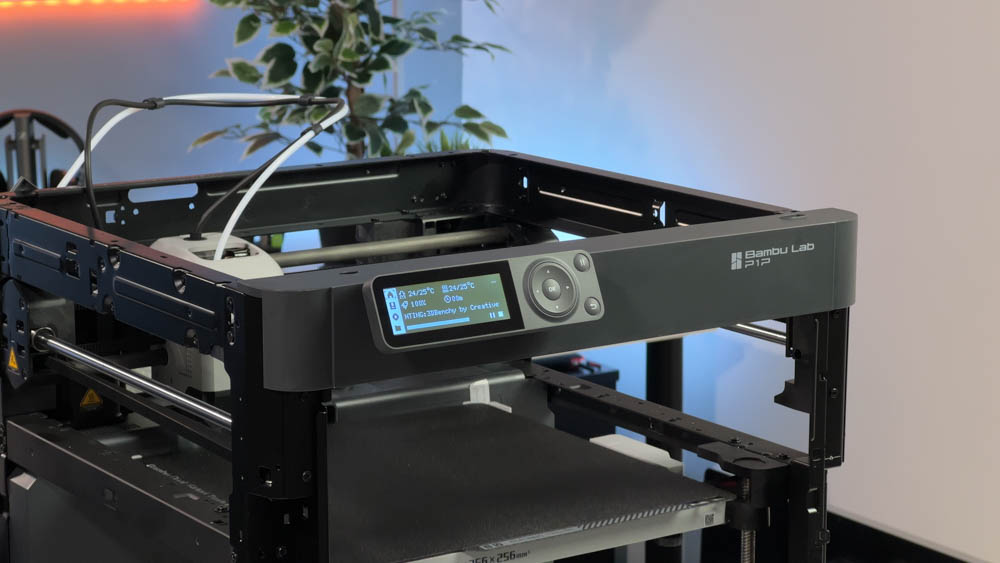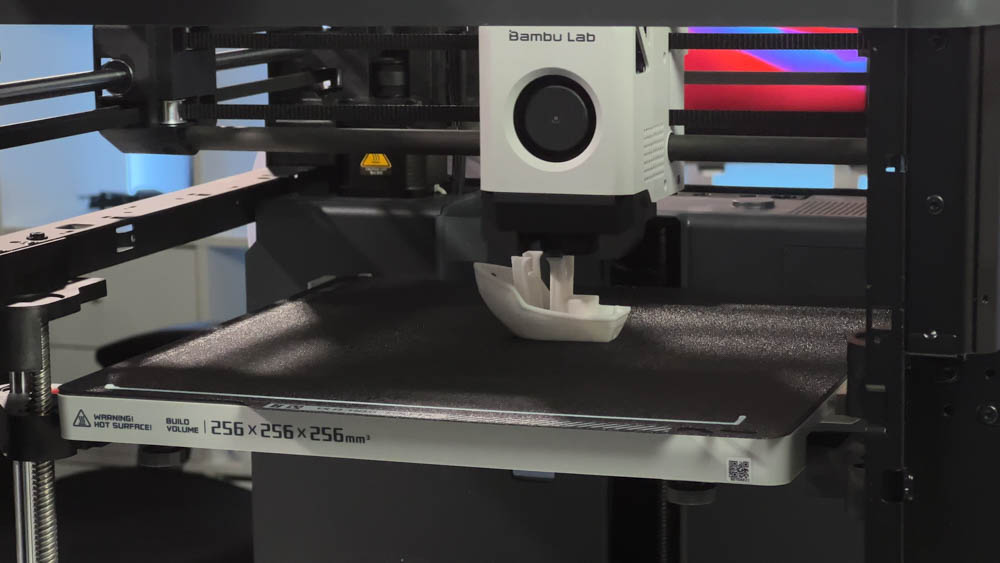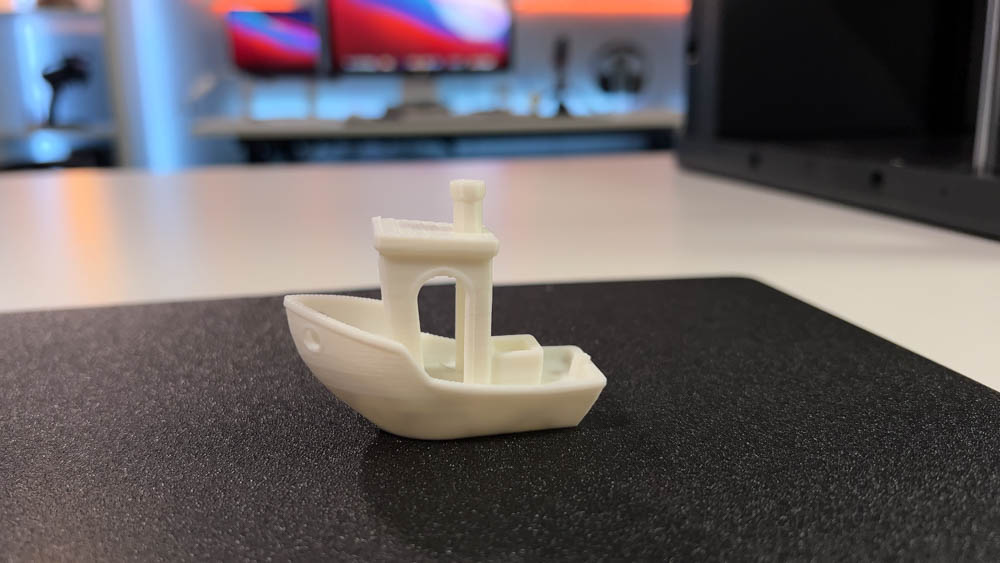

The Bambu Lab P1P is a strong competitor in the 3D printing market. It stands out because of its very fast printing speed, great quality, and low cost. It changes the usual ideas about what a printer in this price range can do.
The Bambu Lab P1P has a special design that is different from other printers. When you first see it, it might look like it is not completely built. This is because it has an open frame without side panels. This design is done on purpose to let users easily change or add things to the printer. Even though the printer does not weigh much, it is still very sturdy and well-made. However, it might be even better if the base of the printer was made of a heavier metal.
Using this printer is easy, even for beginners. Putting it together is simple and does not require a lot of steps. Also, if you need to fix something or want to improve the printer, it is easy to do so. This printer is designed to be convenient for users to handle regular maintenance and to make upgrades without much hassle.

The Bambu Lab P1P 3D printer features a high-performance extruder that significantly contributes to its exceptional printing capabilities. This direct-drive extruder is designed for precision and consistency in filament feeding, which is crucial for maintaining the high-quality prints that the P1P is known for. Capable of handling a wide range of materials, including challenging filaments like nylon and polycarbonates, the extruder can reach high temperatures, thus expanding the printers versatility. This all-metal hot end system, while not supporting nozzle replacements (you have to buy a whole hotend but at least it is easy to replace), offers a maximum printing temperature of 300 C, ensuring compatibility with more complex filaments. The design of the extruder, including a magnetic removable fan cover, makes maintenance and part replacement straightforward, thereby enhancing the overall user experience with the P1P. This advanced extruder system plays a vital role in the printers ability to deliver fast, reliable, and high-quality prints, making the Bambu Lab P1P a standout choice in its market segment. The printing surface is great. It is a Dual-Sided Textured PEI Plate, sized at 256x256 mm, which provides excellent adhesion for a variety of materials and ensures easy removal of finished prints. The bed can heat up to 100 C, accommodating a wide range of filament types. This heated bed, combined with its unique size and coating, plays a crucial role in the printers ability to produce consistent and high-quality prints.

The control interface of the Bambu Lab P1P, though basic, is effectively functional. Its 2.7-inch monochrome display might remind users of a simple display on a basic washing machine, featuring a resolution of 192 x 64 pixels. This type of display, which avoids the modernity of a full-colour touch screen, offers a straightforward, simple approach to navigating the printers settings and functions. Users interact with the printer primarily through a click wheel, a method that, while less intuitive than a touchscreen, provides reliable control over the machines operations. The simplicity of this interface ensures that the essential functions of printing and calibration are accessible, but it may fall short of the expectations of those accustomed to more advanced, interactive displays commonly found in contemporary technology. The lack of a more sophisticated touchscreen might be seen as a drawback, especially considering the advanced nature of the printer.
Setting up the P1P is a remarkably quick and simple process, reflecting Bambu Labs dedication to user-friendliness. The printer arrives mostly pre-assembled, which greatly reduces the initial setup time compared to other 3D printers that require more complex assembly. The key steps in the setup involve removing transport locks (mainly securing screws for the build plate) and a few other minor adjustments. Additional setup tasks include assembling the spool holder, the filament guide, and attaching the control screen, which is designed to snap easily into place. This process, typically taking about 20 minutes, is straightforward and well-guided, making it approachable even for beginners in 3D printing. Upon first powering up, the printer prompts a series of reminders to ensure everything is positioned correctly and ready for operation. It then conducts a self-diagnosis to check all connections and the machines readiness, simplifying the setup process further. The overall design of the P1Ps setup is focused on ease and efficiency, enabling users to commence printing with minimal delay.

The software compatibility of the Bambu Lab P1P extends beyond its native Bambu Studio, a user-friendly slicer based on PrusaSlicer. Bambu Studio is designed to cater to a wide audience, from beginners to experienced users, offering an impressive array of features for print preparation and management. This software provides a comprehensive suite of tools necessary for optimizing prints, making it a robust choice for managing the P1Ps capabilities. Additionally, the P1Ps compatibility with third-party software adds a layer of versatility, allowing users to choose their preferred slicing tools based on their experience and specific project needs. This flexibility in software options ensures that users can experiment with different slicer settings and features, tailoring their experience to achieve the best possible print results.
The Bambu Lab P1P boasts exceptional Wi-Fi connectivity, which significantly enhances the overall user experience. This feature allows for seamless integration with the Bambu Studio software, facilitating remote monitoring and control of print jobs. Users can conveniently access the printer through a computer or mobile device, adding a level of convenience and accessibility to the printing process. The inclusion of Wi-Fi connectivity also opens the door for easy software updates and access to online resources, ensuring that the printer remains up-to-date with the latest features and improvements. This advanced connectivity feature positions the P1P as a modern, network-integrated 3D printer, suitable for both home and professional environments. But we cannot forgive the small reminder that if you have top-secret prints, it may not be the best idea to hook it up to the internet.

The Bambu Lab P1P sets a high standard for 3D print quality, consistently delivering exceptional results. Its ability to maintain superb print quality even during high-speed prints is a testament to its advanced engineering. The printer strikes a balance between speed and detail, ensuring that intricate designs and fine details are faithfully reproduced. Whether you are printing intricate figurines, functional prototypes, or large-scale objects, the P1Ps precision and attention to detail make it a top choice for discerning 3D printing enthusiasts. The quality of prints achieved with this printer rivals those produced by more expensive and specialized machines, making it a valuable addition to any makers toolkit.
One of the standout features of the Bambu Lab P1P is its exceptional reliability. Users can rely on this printer for consistent and trouble-free performance, with minimal issues that might disrupt their printing workflow. Its robust construction and thoughtful design contribute to its reliability, ensuring that it can handle extended printing sessions without compromising on quality or accuracy. Whether you are a hobbyist, educator, or professional, the P1Ps reliability instills confidence that your 3D printing projects will be completed successfully and without unnecessary hiccups, saving you time and effort in the long run.
The inclusion of a filament run-out sensor is a practical enhancement that significantly improves the usability of the Bambu Lab P1P. This sensor is a valuable addition for users who frequently print large or time-consuming projects. When the printer detects that the filament is running low or has run out, it automatically pauses the print job. This feature prevents incomplete prints due to filament depletion and allows users to replace the filament spool seamlessly. The filament sensor not only saves time and material but also provides peace of mind, especially during long overnight prints or when printing multiple objects consecutively.
The Bambu Lab P1P goes the extra mile to ensure a hassle-free 3D printing experience, even in the face of unexpected power outages. With its power loss recovery feature, users no longer need to worry about print failures caused by sudden power interruptions. In the event of a power outage, the printer can resume the print job from where it left off once power is restored. This feature is a game-changer for those who live in areas with unreliable power grids or for users who simply want added assurance that their prints will not be wasted due to unforeseen disruptions. It exemplifies the P1Ps commitment to providing a user-friendly and dependable 3D printing solution that caters to the needs of a diverse user base.

When evaluating the Bambu Lab P1P in terms of value for money, it is clear that this 3D printer offers outstanding value for money to its users. For its price, the P1P achieves a remarkable balance between affordability and the inclusion of high-end features typically found in more expensive models. This approach will appeal to both newcomers to the world of 3D printing and experienced enthusiasts looking for a reliable and cost-effective solution. And just look at the speed, it is incredible.
Pros:
Incredible printing speed
Exceptional print quality
Customizable design
Affordable price
Cons:
Basic control interface
DIY enclosure if you want one
Absence of full-color touchscreen
Print Technology: Fused Deposition Modeling
Build Area: 256x256x256 mm
Dimensions: 386x389x458 mm
Weight: 9.65kg
Bed: Heated, Dual-Sided Textured PEI Plate
Print Speed: Up to 500mm/s
Supported Materials: PLA, ABS, PETG